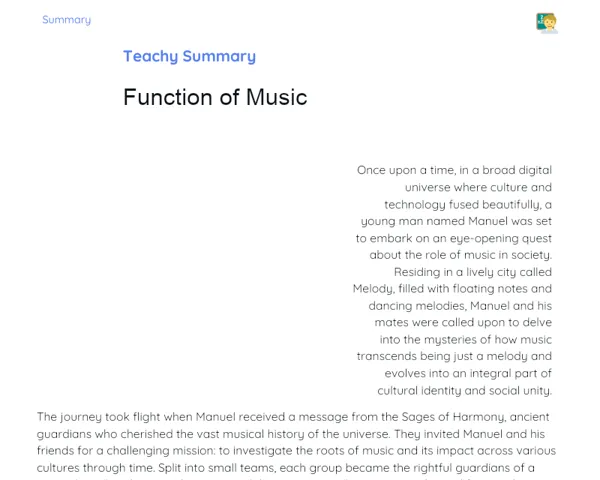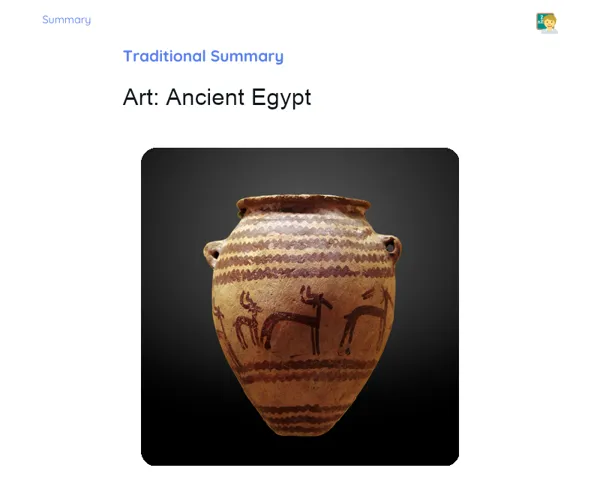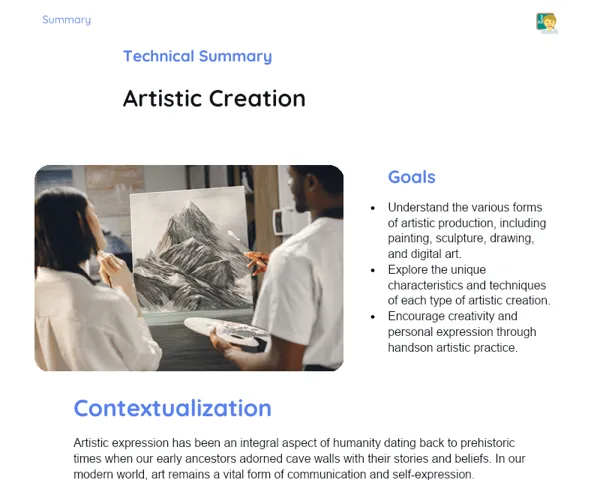Summary Tradisional | Visual Expression
Contextualization
Visual expression is one of the oldest and most universal forms of human communication, harking back to the cave paintings made by our ancestors. Over the years, visual art has grown and transformed, embracing a variety of styles and movements such as the Renaissance, Baroque, Impressionism, and Modernism. Each of these eras introduced new techniques and approaches, reflecting the cultural, social, and technological shifts of their time.
Today, visual art isn't just confined to traditional paintings and sculptures. It spans a vast range of media, including photography, graphic design, film, and even the images that fill our social media feeds daily. Grasping the basics of visual art and its elements—like line, shape, colour, texture, space, and composition—is crucial for truly appreciating these artistic expressions and their impact on our everyday lives.
To Remember!
History of Visual Art
The history of visual art is a captivating journey that starts with the earliest human representations found in caves. Cave paintings, seen in iconic sites like Lascaux in France and Altamira in Spain, highlight our intrinsic desire to document and share visual experiences. Civilisations like the Egyptians, Greeks, and Romans crafted distinctive artistic styles, each beautifully reflecting their unique cultures and values.
The Middle Ages saw visual art heavily influenced by religion, producing stunning icons and frescoes that adorned churches and cathedrals. The Renaissance ushered in a transformation in visual art, focusing on perspective, proportion, and realism. Artists such as Leonardo da Vinci, Michelangelo, and Raphael explored innovative techniques and themes, taking art to new heights.
In subsequent centuries, movements like Baroque, Rococo, Neoclassicism, Romanticism, Realism, and Impressionism constantly challenged the limits of visual art. Each movement introduced fresh approaches and techniques, mirroring the social, political, and technological transformations of its era. Then, in the 20th century, Modernism and its many branches—like Cubism, Surrealism, and Expressionism—questioned traditional norms and paved the way for contemporary art.
-
Cave paintings are the earliest examples of visual art.
-
The Renaissance revolutionised artistic techniques, focusing on perspective and realism.
-
Movements like Baroque, Impressionism, and Modernism reflected cultural and technological progress.
Elements of Visual Art
The elements of visual art are fundamental components that help create and interpret works of art. These include line, shape, colour, texture, space, and composition. Lines can define shapes, create outlines, guiding the viewer’s eye. They can be straight or curved, thin or thick, with each variation conveying different emotions and movements.
Shapes can be distinct areas defined by lines or contrasts in colour and texture. They can be geometric (like squares and circles) or organic (like natural forms). Colour is an incredibly powerful element that can stir emotions, set moods, and highlight certain aspects of a work. Understanding colour theory, which includes concepts like primary, secondary, and complementary colours, is vital for the effective use of colour in art.
Texture pertains to the artwork’s surface, which can be real (as in a sculpture) or illusionary (like in a painting that simulates texture). Space pertains to how the elements are arranged in relation to each other, creating the sense of depth and perspective. Composition is about how these elements are organized in the artwork, and a successful composition skillfully directs the viewer’s eye in a cohesive and intentional way.
-
Line, shape, colour, texture, space, and composition are essential elements of visual art.
-
Colour can evoke emotions and influence the mood of a work.
-
Composition organizes the elements of art, crafting a harmonious visual experience.
Techniques and Materials in Visual Art
Visual art embraces a variety of techniques and materials, each offering unique characteristics and expressive possibilities. For instance, painting can be executed with various types of paint, such as oil, acrylic, and watercolour. Each type of paint delivers different results in terms of gloss, opacity, and drying time, affecting the final outcome of the artwork.
When it comes to sculpture, artists create three-dimensional forms using materials like stone, metal, wood, and clay. Sculpting techniques can include carving, modelling, and casting. Photography—a relatively modern art form—involves capturing images with a camera where photographers can play with light, shadow, and composition to create striking and evocative visuals.
Graphic design merges text and imagery to convey messages effectively, and it’s widely employed in advertising, digital media, and publishing. With the rise of digital technology, new methods and tools have come into play, making it easier to create visual art on digital platforms. Software like Adobe Photoshop and Illustrator is commonly used to craft and edit digital images.
-
Painting uses different paints, each with particular qualities.
-
Sculpture shapes three-dimensional forms from materials like stone and metal.
-
Photography and graphic design represent modern forms of visual art that leverage digital technology.
Interpretation and Critique of Visual Art
Interpreting and critiquing visual art involves analysing and evaluating artworks, considering various aspects such as historical context, the artist’s intentions, and emotional resonance. Interpretation aims to uncover the meaning and messages an artist aims to communicate through their work, often looking at symbols, themes, and techniques employed.
Art critique extends beyond mere interpretation and assesses the quality and effectiveness of the work. Critics examine elements like originality, technique, and the contribution of the work to the art world. While critique can be subjective—reflecting personal views and preferences—it should also be informed by a robust understanding of art.
Common questions in the interpretation and critique of art include: 'What message is the artist trying to convey?', 'What feelings does the artwork evoke?' and 'How do the techniques and materials used influence the piece?'. Art criticism is vital for assessing and comprehending artworks, allowing audiences to appreciate the rich depth and complexity of artistic expression.
-
Interpretation seeks to grasp the meaning and message behind the artwork.
-
Art critique evaluates the work's quality and effectiveness, focusing on originality and technique.
-
Common questions revolve around the artist's intention and the feelings prompted by the artwork.
Key Terms
-
Visual Art: An expression of creativity that utilizes visual elements as its primary mode of appreciation.
-
Art History: The exploration of how visual arts have evolved through time.
-
Art Elements: Fundamental components that artists utilize to create and interpret works of art, such as line, shape, colour, texture, space, and composition.
-
Artistic Techniques: Methods and processes applied in the creation of artworks, including painting, sculpture, photography, and graphic design.
-
Art Interpretation: The analysis of meanings and messages conveyed by a piece of art.
-
Art Critique: The assessment of an artwork’s quality and effectiveness, focusing on originality and technique.
Important Conclusions
Visual expression serves as a fundamental method of human communication and has undergone significant evolution over the centuries. From the earliest cave artworks to modern expressions like photography and graphic design, visual art remains a powerful means of conveying ideas, emotions, and stories. The fundamental elements of visual art—line, shape, colour, texture, space, and composition—are crucial tools that artists employ to produce their works and articulate their messages.
Understanding the techniques and materials used in visual art, from traditional painting to contemporary digital media, is essential for appreciating the field’s diversity and innovation. The interpretation and critique of visual art enable a deeper, more reflective analysis of artworks, helping to uncover hidden meanings and weigh the quality and impact of artistic expressions. This process not only enhances one’s appreciation of artworks but also fosters the critical thinking skills of students.
Visual art permeates many aspects of our daily lives, shaping our perceptions and behaviours through advertising, social media, and various visual communication forms. Thus, insights into visual expression are profoundly relevant, empowering students to become discerning consumers and appreciative observers of the rich artistic and cultural offerings around them.
Study Tips
-
Review the basic elements of visual art and try to identify each one in different artworks.
-
Visit local museums, art galleries, or explore online galleries to experience a diverse range of artworks and styles.
-
Practice interpreting and critiquing visual art by writing your thoughts on pieces you find interesting or thought-provoking.



